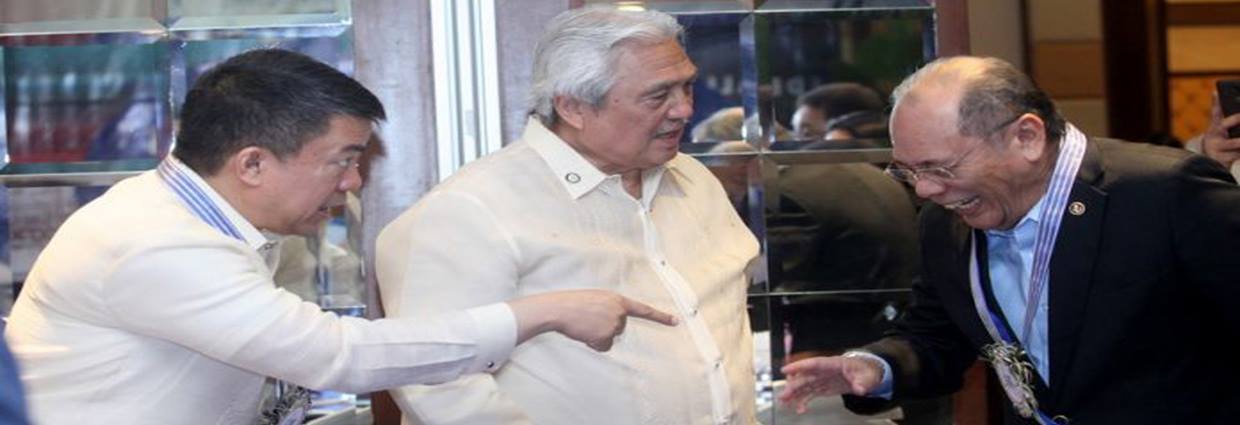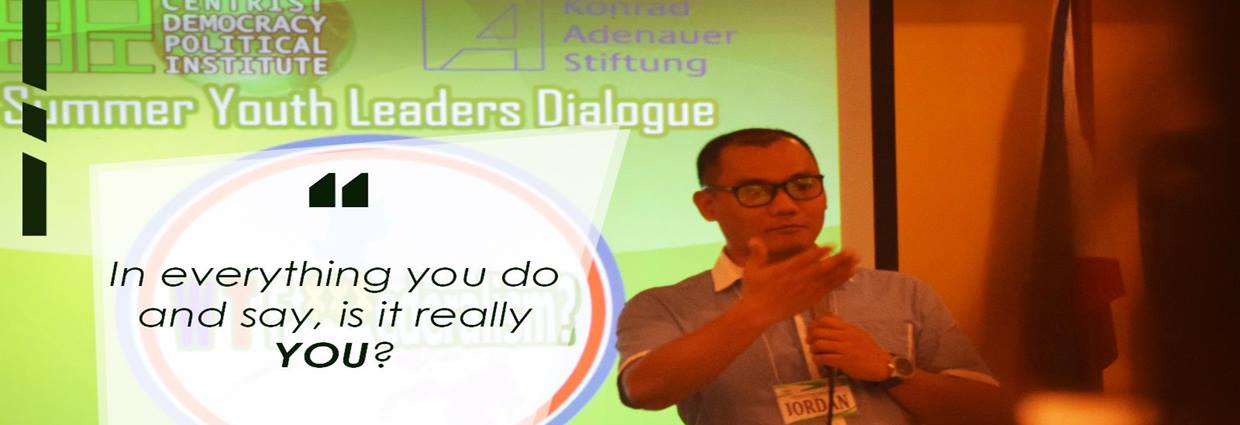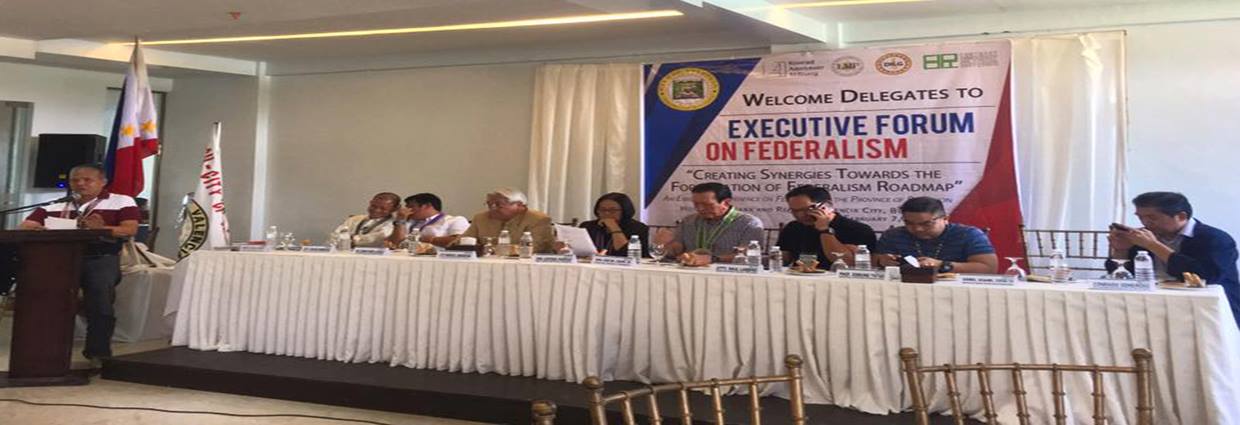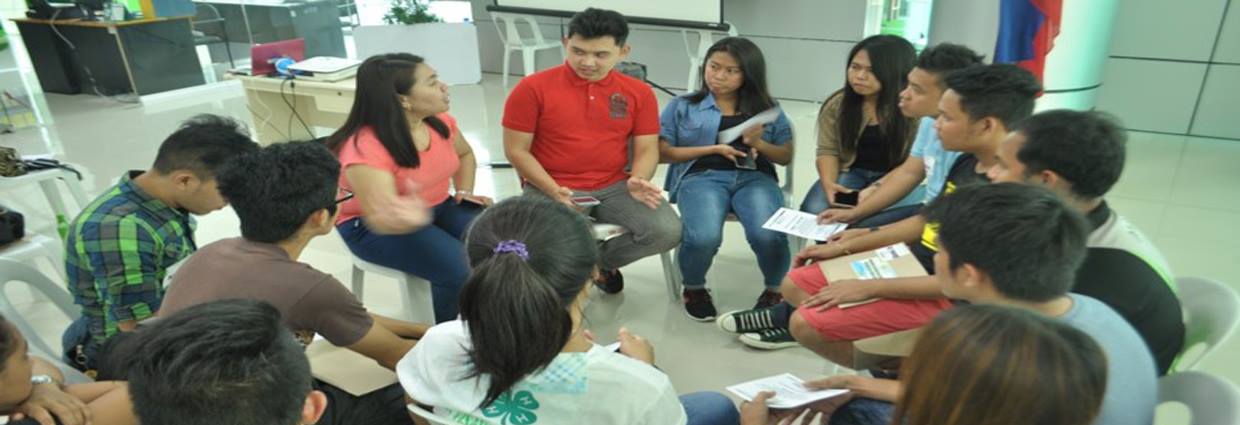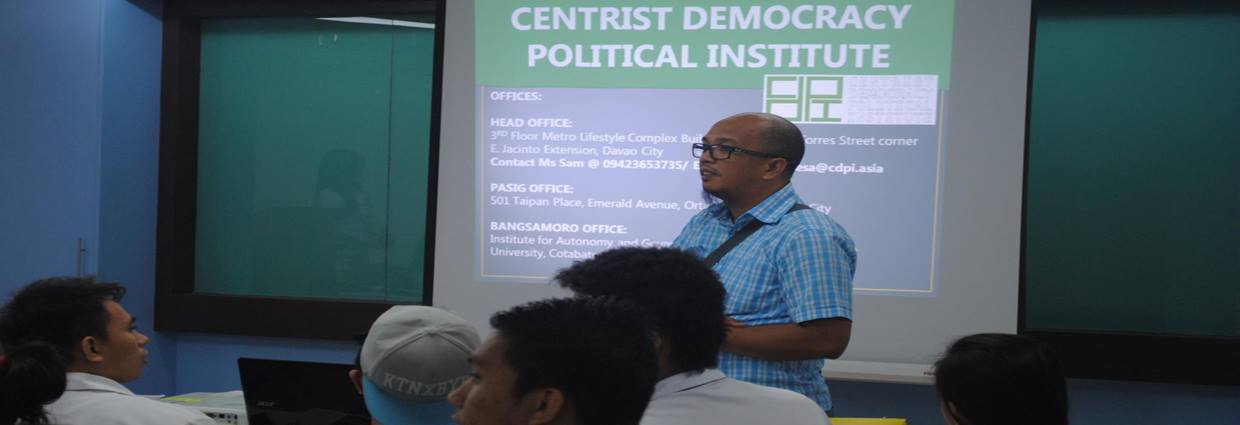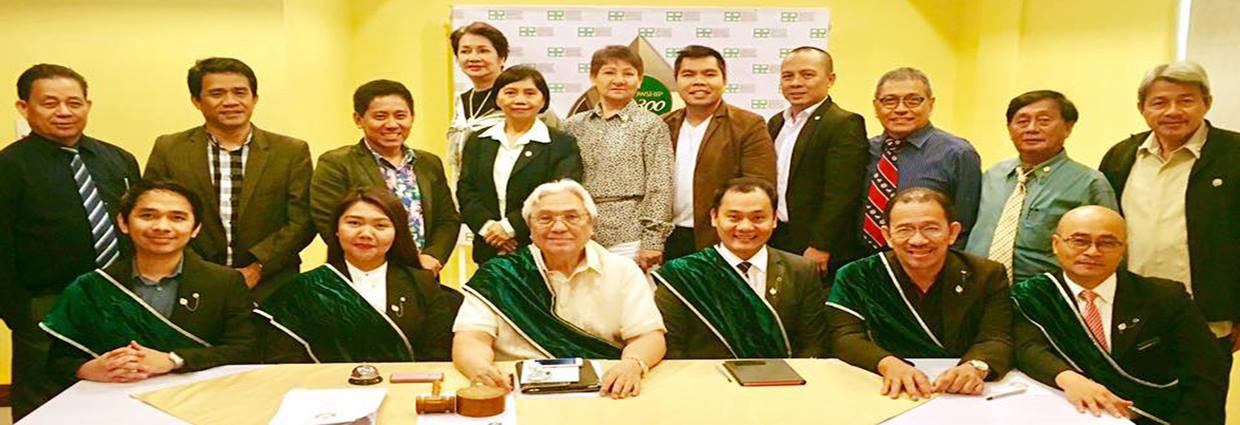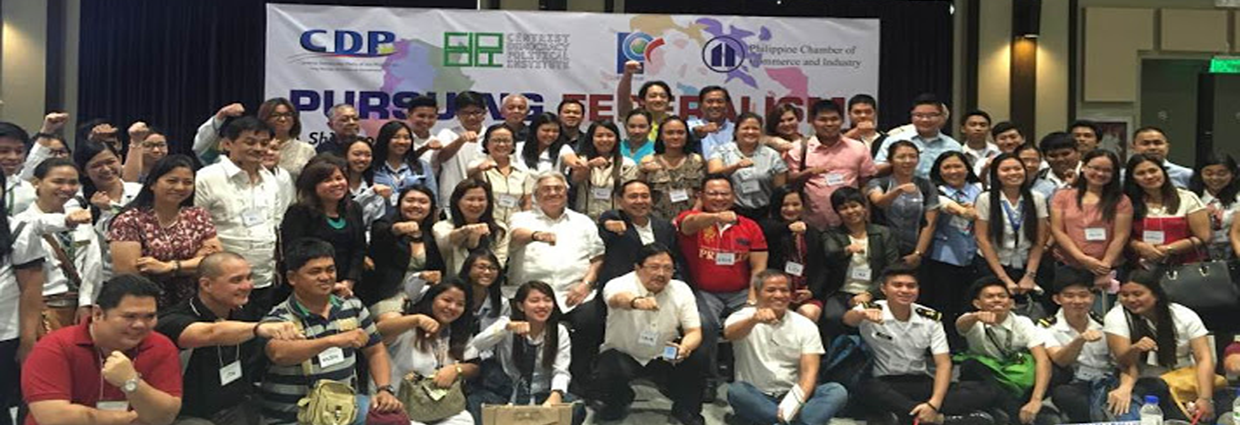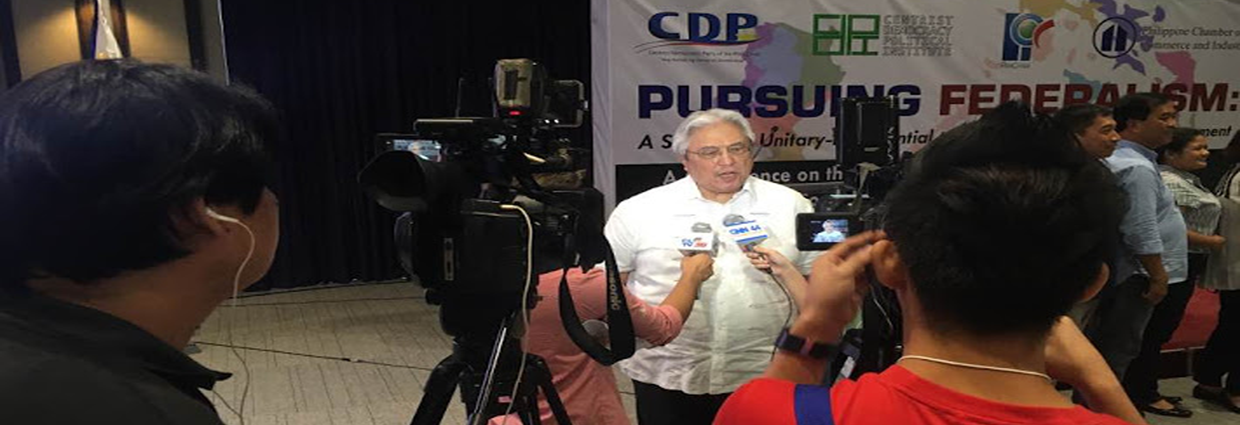Centrist Democracy Political Institute - Items filtered by date: December 2025
Friday, 22 September 2017 09:42
BOC-Davao, AFP, other agencies ink MOA to strengthen border security
Lawyer Erastus Sandino B. Austria, district collector of the Bureau of Customs-Port of Davao joined on September 15 other government officials in signing a memorandum of agreement (MOA) creating the country’s first Inter-Agency Border Security Coordinating Council.
The MOA was a product of the series of inter-agency meetings which the Eastern-Mindanao Command (East-Min Com) of the Armed Forces of the Philippines (AFP) coordinated.
The council hopes to curb the entry of terrorism as well as prevent illegal activities in its area of responsibility. According to a press statement by the East-Min Com, the Martial Law currently in place has driven the AFP to strengthen border security.
“[We are] continuously strengthening the border security to prevent terrorism, violent extremism, and other crime syndicates from entering the country via the southern border,” the press statement reads.
After the signing of the MOA, representatives from the regional government agencies elected the council’s officers.
East-Min Com, represented by Lt. Gen. Rey Leonardo Guerrero, holds the chairmanship. Representatives from Police Regional Office (PRO) XI, Civil Aviation Authority of the Philippines (CAAP XI), Naval Forces Eastern Mindanao (NFEM), Department of Interior and Local Government (DILG) XI, and the National Intelligence Coordinating Agency (NICA) XI were the five elected vice chairpersons.
Other signatories to the MOA are the Philippine Ports Authority-Port Management Office Davao, Philippine Coast Guard, National Bureau of Investigation-Central Mindanao Regional Office, and the Philippine Drug Enforcement Agency XI. | BOC-PR
Published in
News
Thursday, 21 September 2017 10:19
Duterte to join ‘Day of Protest’
PRESIDENT Rodrigo Duterte plans to join today’s “National Day of Protest” he had proclaimed, saying he would rally against the “Yellows” or members of the erstwhile ruling Liberal Party as well as corruption in some government agencies.
In a late-night interview aired Tuesday on state-run People’s Television Network, Duterte said he would also protest on the day of mass demonstrations marking the 45th anniversary of Martial Law declared by President Ferdinand Marcos in 1972.
“I’d be happy to join those who have sentiments on government, extrajudicial killings, corruption – that’s also my sentiments now – and other government abuses. Then, I’m inviting everybody, including deprived Lumads to come down and join the protests,” the President said.
“That’s why I called it (September 21) National Day of Protest – to give them space and time to enjoy the rights to peacefully assemble, seek redress, and air their grievances. Vent your ire on any place you want – public property and not private,” he added.
The President said he would express his disapproval of “corrupt” government offices supposedly ran by the opposition.
“I will also protest because there are so many ‘yellow’ people who are working in the commission bodies. They are corrupt. Even those on the regulatory board. I will protest because they have a fixed term, there’s a security of tenure. Meaning, you can’t remove them easily,” he said.
Proclamation 319, which Duterte signed on September 19, declared Thursday, September 21, as a National Day of Protest “in solidarity with the people’s call against all excesses and shortcomings of the government, and with the people’s desire to uphold the highest standards of integrity, efficiency and accountability in government.”
“I urge all protesters to act within the bounds of the law, maintain a peaceful conduct of rallies, marches and demonstrations, be vigilant of possible infiltrators who may instigate violence in an effort to provoke the police and other law enforcement authorities, and avoid causing undue inconvenience to their fellow citizens,” Duterte said in his order.
“I hereby order all police and other law enforcement authorities to observe maximum restraint and maintain such distance from these assemblies and mass actions as may be necessary to allow protesters the full exercise of their rights within the bounds of the law,” he added.
The Office of the Executive Secretary on Wednesday released a memorandum circular suspending classes in public schools and work in government offices today, September 21.
Malacañang, meanwhile, left it to the “sound discretion” of heads of private companies and schools to decide whether they, too, would call off work and classes.
In a statement, Palace spokesman Ernesto Abella said the memorandum circular covered only the Executive branch and local government units.
Abella said agencies under the Executive branch that deal with basic and vital services or those dealing with disasters and emergencies are ordered to be on standby near protest sites.
“I’d be happy to join those who have sentiments on government, extrajudicial killings, corruption – that’s also my sentiments now – and other government abuses. Then, I’m inviting everybody, including deprived Lumads to come down and join the protests,” the President said.
“That’s why I called it (September 21) National Day of Protest – to give them space and time to enjoy the rights to peacefully assemble, seek redress, and air their grievances. Vent your ire on any place you want – public property and not private,” he added.
The President said he would express his disapproval of “corrupt” government offices supposedly ran by the opposition.
“I will also protest because there are so many ‘yellow’ people who are working in the commission bodies. They are corrupt. Even those on the regulatory board. I will protest because they have a fixed term, there’s a security of tenure. Meaning, you can’t remove them easily,” he said.
Proclamation 319, which Duterte signed on September 19, declared Thursday, September 21, as a National Day of Protest “in solidarity with the people’s call against all excesses and shortcomings of the government, and with the people’s desire to uphold the highest standards of integrity, efficiency and accountability in government.”
“I urge all protesters to act within the bounds of the law, maintain a peaceful conduct of rallies, marches and demonstrations, be vigilant of possible infiltrators who may instigate violence in an effort to provoke the police and other law enforcement authorities, and avoid causing undue inconvenience to their fellow citizens,” Duterte said in his order.
“I hereby order all police and other law enforcement authorities to observe maximum restraint and maintain such distance from these assemblies and mass actions as may be necessary to allow protesters the full exercise of their rights within the bounds of the law,” he added.
The Office of the Executive Secretary on Wednesday released a memorandum circular suspending classes in public schools and work in government offices today, September 21.
Malacañang, meanwhile, left it to the “sound discretion” of heads of private companies and schools to decide whether they, too, would call off work and classes.
In a statement, Palace spokesman Ernesto Abella said the memorandum circular covered only the Executive branch and local government units.
Abella said agencies under the Executive branch that deal with basic and vital services or those dealing with disasters and emergencies are ordered to be on standby near protest sites.
Published in
News
Wednesday, 20 September 2017 09:15
ASEAN Radicalisation, violent extremism top agenda of ASEAN ministers’ meet
Cognizant of the existence of radicalization and violent extremism in the ASEAN (Association of Southeast Asian Nations), ASEAN ministers today further reaffirmed their commitment to work together to prevent and counter these twin concerns that are becoming huge challenges in the region.
The ASEAN ministers and other official delegates are in the country for the Second Special ASEAN Ministerial Meeting on the Rise of Radicalisation and Violent Extremism or 2nd SAMMRRVE.
Department of the Interior and Local Government OIC Secretary Catalino S. Cuy, who is also the ASEAN Ministerial Meeting on Transnational Crime Leader for the Philippines, says the SAMMRRVE is convened to provide a platform (AMMTC) for ASEAN member states to exchange experiences, views and ideas on the best practices in handling the issues of radicalization and violent extremism particularly in South East Asia.
“It is of our mutual interest and benefit to guard the peace and order of our region as an indispensable requisite for ASEAN socioeconomic prosperity,” says Cuy.
“This Ministerial Meeting showcases regional solidarity and resolve to tackle both issues,” he adds.
In 2015, ASEAN first took note of these twin issues that were long overlooked by the region during the first SAMMRRVE which was held in Malaysia.
“There are serious and various challenges in counteracting radicalization and violent extremism but with our regional cooperation on peace and order, we as one ASEAN, can model and light the way for other regional organizations in the world,” says Cuy.
The meeting provided an opportunity for the ASEAN ministers to exchange views and experiences on the unique challenges that their respective countries are encountering in dealing with these concerns as well as on the rehabilitation aspect.
At the same time, ASEAN ministers also discussed possible areas of collaboration in the region to counter radicalization and violent extremism.
Among possible regional initiatives are the conduct of regular regional dialogues and consultations, exchange of intelligence information and resources, establishing joint operations, and engaging regional partners in capacity building programs.
“We say this not out of habit but out of genuine belongingness: we are one ASEAN community with one shared identity and one vision,” says Cuy.
“That is why we have a united resolve to guard our regional peace and stability and we cannot be intimidated by radical and violent extremist groups from within and without,” he adds. | DILG
Published in
News
Tuesday, 19 September 2017 10:14
Duterte on ties with Marcoses: Utang na loob? It’s not that
It is not about repaying a debt of gratitude, President Rodrigo Duterte has said about his ties with the family of late dictator Ferdinand Marcos.
Before public lawyers, Duterte on Monday explained anew his deep ties with the Marcoses, which began “since time immemorial.”
“Those are things that cannot really be gawaing issue because those are relationships that were cemented many years ago,” he said.
“But kung sabihin niyo that I bargained away the ends of justice to repay utang na loob, it’s not that. Marcos was supported by my father, he won. So Marcos got him into the Cabinet, it’s natural, that’s politics, even everywhere,” he added.
He reiterated that his late father, Vicente Duterte who was the former governor of the undivided Davao, was a Cabinet member during the first term of Marcos.
Duterte did not provide any reason why he brought up his family’s relationship with the Marcoses, but he recently revealed that Ilocos Norte Governor Imee Marcos reached out to him to discuss about the possible return of the ill-gotten wealth.
The President also reiterated that Gov. Marcos was one of the three governors who supported him during the May 2016 elections. — DVM, GMA News
Published in
News
Friday, 15 September 2017 13:50
CDPI proposes shift to Federal-Parliamentary System
The Centrist Democracy Political Institute (CDPI) on Thursday, September 14, said it is proposing the shift to a federal parliamentary system, adding that Congress should soon start deliberating the amendments in the 1987 Constitution that will pave the way for federalization.
Lito Monico Lorenzana, President of the CDPI, said they will be presenting this proposal to the 25-man commission to be appointed by President Rodrigo Duterte.
CDPI is a political, non-profit organization, in partnership with the Konrad Adenauer Stiftung Philippines, a German political foundation which promotes political education initiatives worldwide.
“We want a system where power and authority are not centralized but shared between the federal government and the states --- we call these regions, sub-states,” Lorenzana said in a press briefing in Malacañan.
“We have several models of federalism already submitted to Congress. We are presenting to you today a model borne out of years of discernment and study,” he said.
According to Lorenzana, the CDPI’s proposal adopted and updated the 2005 Consultative Commission documents, which they call “The Centrist Proposal.”
“In our proposal, the Centrist Proposal, the legislative and the executive are fused… We fuse them in a unicameral parliament, one body. And the head of government is the Prime Minister --- with his Cabinet recruited among the members of parliament,” Lorenzana said.
He said the President, as head of state, shall be elected from among the members of parliament and shall have a five-year term while the Prime Minister or the head of government will have no term limits but can be booted out of office through a vote of no confidence, not through the process of impeachment.
Lorenzana said the CDPI has four preconditions while revising the 1987 Constitution: political party reform, enactment of a law banning political dynasties; the passage of a real all-encompassing Freedom of Information Act; and electoral reforms.
“We penalize turncoatism or the switching of political parties, the balimbings, the political butterflies,” Lorenzana said.
As for electoral reforms, he said the Commission on Elections (COMELEC) must be reformed to remove all quasi-judicial work and transfer electoral contests and protests to the judiciary.
“These four conditions have a high probability of passage while we have a President endowed with tremendous political capital and have the political will to act decisively,” he said.
Lorenzana said the CDPI has also proposed timelines, which urges Congress to start deliberating amendments in the 1987 Constitution from October this year up to February 2019.
The second stage will be from May of 2020 to 2025, wherein the first parliamentary elections under the new federal Constitution shall be conducted not later than May 2020 “to organize the first unicameral parliament under the newly-ratified Constitution with a term of five years up to 2025.”
From May 2025 to 2030, the second regular parliamentary elections under the new Constitution shall be held by 2025 with a five-year term to 2030. The country will then have a new Prime Minister and a new President, he said.
“That is the shift to parliamentary… But the process of federalization goes on,” Lorenzana said.
In terms of federalization, Lorenzana said the Centrist Position calls for 11 autonomous territories.
The 12th autonomous territory, the Bangsamoro, will be constituted ahead of the Bangsamoro because of the Bangsamoro Basic Law enacted by Congress previous to the plebiscite, Lorenzana said.
Lorenzana said that by 2028, autonomous territories may already operate like federal states.
“They can raise their own funds. They can come up with their own resources. They can come up with their own taxes and spend for themselves. It is a kind of federalism we aspire for where the people from cities and regions shall negotiate among themselves and arrive a decision to set up their own federal state,” he said.
Lorenzana said the process of shifting to a federal type of government may take some time, and would need massive political education, especially among millennials.
“The Centrist roadmap to federalism is designed to mitigate the shock to the body politic arising from the purging of traditional political practices to the immediate passage of reform laws now pending in Congress,” he said.
Published in
News
Friday, 15 September 2017 08:45
‘Rody should remain head of federal gov’t’
MANILA, Philippines — President Duterte should remain head of state if ever the country shifts to a federal form of government.
At a Malacañang briefing on federalism yesterday, Lito Monico Lorenzana, president of the Centrist Democracy Political Institute (CDPI), said Duterte should stay in office during the transition period.
“President Duterte…should continue his dual role as head of state...and head of government, leading and presiding over the new unicameral parliament. We need him up to 2022,” Lorenzana said.
Former Senate president Aquilino Pimentel Jr. expressed the same view in an earlier Palace-initiated briefing on federalism.
Lorenzana said they would present their proposal to the 25-member commission to be appointed by the President.
He said the CDPI’s proposal adopted and updated the 2005 consultative commission documents.
“In our proposal…the legislative and the executive are fused…The head of government is the prime minister, with his Cabinet recruited among members of the parliament,” Lorenzana said.
He said Congress should start its discussions on the shift to a federal form of government next month.
Lorenzana said the first parliamentary elections should be held not later than May 2020.
At a Malacañang briefing on federalism yesterday, Lito Monico Lorenzana, president of the Centrist Democracy Political Institute (CDPI), said Duterte should stay in office during the transition period.
“President Duterte…should continue his dual role as head of state...and head of government, leading and presiding over the new unicameral parliament. We need him up to 2022,” Lorenzana said.
Former Senate president Aquilino Pimentel Jr. expressed the same view in an earlier Palace-initiated briefing on federalism.
Lorenzana said they would present their proposal to the 25-member commission to be appointed by the President.
He said the CDPI’s proposal adopted and updated the 2005 consultative commission documents.
“In our proposal…the legislative and the executive are fused…The head of government is the prime minister, with his Cabinet recruited among members of the parliament,” Lorenzana said.
He said Congress should start its discussions on the shift to a federal form of government next month.
Lorenzana said the first parliamentary elections should be held not later than May 2020.
Published in
News
Friday, 15 September 2017 07:54
Federal shift could extend Duterte’s term – expert
President Duterte could extend his term until 2025 under the proposed federal parliamentary government, according to head of a Centrist Democratic Party (CDP) of the Philippines.
Lito Lorenzana, chair of the CDP and president of the Centrist Democracy Political Institute, proposed the term extension for Duterte during the transition period from the unitary presidential system, citing his ”political will” to implement federalism.
Under the CDP proposal, Lorenzana said changes to the Constitution, particularly the shift to federal-parliamentary government, must be introduced next month, followed by a plebiscite by February 2019.
He said the parliamentary elections will then be conducted not later than May 2020 “to organize the first unicameral parliament under the newly ratified Constitution with a term of five years up to 2025.”
“Then the incumbent President Duterte, now in a parliamentary form of government in 2022, shall continue – this is very important – shall continue his dual presidential role as head of state and at the same time as head of government leading and presiding over the new unicameral parliament,” he said.
Lorenzana said President Duterte may also step down by May 2022 to pave the way for his successor elected by the parliament. “Or if the people want or then you put that – you provide that in the transitory provisions of the new Constitution that he will still serve up to that year, okay. This is a choice of the people,” he said.
Duterte, who scored a landslide victory in the 2016 presidential polls, has a six-year term until 2022. Under the Constitution, the President may only serve for one term and is ineligible for reelection.
Lorenzana defended the possible term extension of Duterte to ensure the smooth transition.
“The point is that 40 years we have only one President who says that, ‘We need to shift to federal system of government,” he said.
He said the federalism proposal was proposed during the terms of former President Joseph Estrada and Gloria Arroyo but “we all failed.”
“That’s why we said, we suggest it so that can be put in the transitory provision. Sabagay, it’s only ilang years lang ‘yan (It’s only a few yars” from 2022 man lang eh when he is supposed to step down to 2022 to 2025,” he said.
Federal model
Lorenzana previously served as secretary general of the 2005 consultative commission assigned by then President Arroyo to study and draft changes to the Charter.
In the proposed federalism model, Lorenzana said executive and legislative branches would be fused into a unicameral parliament.
The head of the government will be a Prime Minister with his Cabinet recruited as members of parliament. “The Prime Minister or the head of government can be booted out of office through a vote of no confidence, not the process of impeachment,” Lorenzana said.
The President, on the other hand, will be the head of state and commander-in-chief of all armed forces. He will be elected from the parliament members.
4 preconditions
Lorenzana, meantime, proposed four preconditions to federalism, including reforms in the political party system as well as ban on political dynasty.
He pushed for the passage of the political party development bill, that will penalize turncoatism and enforce transparent mechanism on campaign financing.
“We need real parties, not the type we have today or have had in the past several decades,” he said.
“Political parties are primarily formed not only to contest elections and to grab and hold power in government, but they must possess an ideological core aggregating the needs and aspirations of diverse segment of our society, differentiating each from the other to give the people a chance to choose what they want,” he said.
Lorenzana also said the law banning political dynasties must also be passed as mandated by the Constitution.
“If Congress will not again pass an enabling law, because 80 to 90 percent of Congress are members of dynasty, then what should be written in the revised Constitution should be banning the dynasty – should be self-executory,” he said.
Another condition is the passage of a “real all-encompassing” Freedom of Information law to enforce transparency in government transactions. “This law will allow public access to information pertaining to official acts, transactions or decisions and compel transparency and accountability in public service,” Lorenzana said.
The fourth and last condition is the implementation of electoral reforms “that will not pervert the will of the populace,” according to Lorenzana.
“The Comelec (Commission on Elections) must be reformed to remove all quasi-judicial work and transfer electoral contests and protests to the judiciary,’ he said.
Lorenzana said the CDP proposals on federalism will be transmitted to the Palace-formed consultative commission that will study and recommended amendments to the Charter.
Published in
News
Friday, 15 September 2017 06:49
Under federalism, Duterte may stay till 2025
A federalism advocate on Thursday raised the possibility of extending President Duterte’s term to 2025 while the country adjusts to the shift to a federal parliamentary government.
Lito Lorenzana, president of the Centrist Democracy Political Institute, also said that in the process of revising the Constitution and shifting to a federal system, there are four “critical conditions” that must be met.
These are: the reform of political parties including the penalizing of turncoats; the abolition of political dynasties; the passage of a freedom of information law; and electoral reforms.
Lorenzana, speaking at a Malacañang press briefing, said he believes the country is on the verge of shifting from a unitary to a federal government because Mr. Duterte himself is championing the idea.
Published in
News
Thursday, 14 September 2017 08:35
Doing business in a federal government
WILL it be easier, especially for the micro, small and medium (less than P100 million assets) enterprises to do business under a federal set-up? Since Federalism essentially means a smaller sovereign state (the region) within a larger sovereign state (the federal government) wouldn’t it make it harder for this economic sector, a sector that accounts for over 60 percent of our employment and makes up 99.5 percent of total enterprises, to do business? (These figures are a dead giveaway that MSMEs suffer from low productivity and that economic opportunities are concentrated in a few regions and a few (.5 percent) of the total number of enterprises.
Last week, the Center for Philippine Futuristics Studies and Management, Inc. held a conference with this theme where the keynote address was given by retired Chief Justice Reynato S. Puno. Speakers from Germany and Canada gave excellent inputs on their respective countries’ experience with federalism and business operations. Both have robust MSME sectors.
For the Philippines, since I too am an entrepreneur within this category and a strong advocate for federalism to equalize development opportunities to spread benefits and reduce poverty where it is raging (areas further from Metro Manila), I certainly desire that doing business be made simpler. Because the reality now, under a unitary government set-up is, it is clearly disadvantageous to the MSMEs, particularly those that are in the regions further from Manila. Why?
The first thing to note is that because NCR, Calabarzon and Central Luzon regions, just three regions out of 17 (PRRD nixed Negros Island Region last month), captured almost one-half of total government expenditure in 2016 and having the remaining 14 regions share in the remaining 50 percent, it is but a certainty that MSMEs in those 14 regions will struggle. For government itself is an important market for this sector and having smaller regional budgets deprives them of a more vigorous market for products and services that they can offer. Well, even in the NCR and its two neighboring regions in the north and south, because of the overly large expenditures, it makes it also difficult for MSMEs to muscle in on the big boys who are obviously well-connected and have easy access to government officials and natural resources.
Federalism assures a much better distribution of government expenditures and that alone will encourage MSMEs in other regions to sprout up and meet new demand for goods and services.
But what about business permits? Wouldn’t it be more difficult since now you would have local, regional and national offices to register with? Mr. Julian H. Payne, the president of the Canadian Chamber of Commerce of the Philippines, said that in Canada a business registers with the appropriate set of government offices that is matched with its scope of operations. Meaning, if an enterprise will do business all over Canada, then it gets a federal registration and permits, while if it’s business is limited to one province (their term for a region) then the permits are only applied in that province.
If the Philippines had a federal government structure, then the bulk of the MSMEs would only need to register and be permitted mostly at the municipal and probably regional levels but not anymore at the national level. Even businesses that were only limited, say, to a barangay would only need to register and be permitted at that level. Can you imagine the explosion of new and creative enterprises when both expenditures are increased in faraway regions and it is much easier to register and get permits? Maybe this alone will be a big boost to stop our country’s shameful slide in its economic standing among comparable members of Asean where we are at the bottom of similar countries that did not have a wrenching war and its impacts to overcome. Not only do we have a low per capita GDP but according to the ADB, in 2016 only Myanmar and Laos had slightly higher poverty rates than the Philippines. So, we have low GDP and on top of that, it’s concentrated, leaving behind mostly crumbs or trickles for the majority, thus high poverty rates.
In Canada as in the US, states can make up their own sales tax and other income tax rates and a federal Philippines would be no different. A regional government, say, Region 8 which had a poverty rate of 37 percent in 2014, could determine a more attractive mix of taxes for the business sector and provide incentives for particular industries that make use of the local skills and resources in the area. They will be free to do that at the regional level which gives a sizable enough population (about 6 million people, or 1.2 million households) and combined with a heftier government budget will be an attractive enough market for regional and local enterprises to go after.
When surveyed, MSMEs in developed federal countries spend their energy dealing with the internal dynamics of the enterprises like labor productivity, R&D and innovation, making it more efficient and good enough to go global. Witness the great products from Thailand, etc. Here, because of a very centralized government, MSMEs report that most of their time is spent with external factors like business permits, corruption and taxes. Many transactions are handled by “facilitators and fixers” as red tape and delays can be legendary. This sucks away energy that could have been used to run a better MSME.
Yes, federalism bodes well for the MSME sector. Much more than our present unitary system where the data on their economic performance is very disappointing. Since we encourage our returning OFWs to venture into this sector, we must prepare for the ground to be more fertile that what it presently is.
A co-convenor of Subsidiarity Movement International, and Federalist Forum of the Philippines, the advocates for the bottom-up development model as well as proper decentralization; and the strengthening of regional governance. He served for 12 years in the Regional Development Council of Central Luzon as chair of the economic committee. He is a member of the board of advisors of CDPI.
Published in
Commentaries
Thursday, 14 September 2017 08:13
Duterte has his share of incompetent officials
The Catholic Bishops Conference of the Philippines (CBCP) has joined local and international human rights groups in decrying the extrajudicial killings.
Police and vigilantes have killed thousands of people involved in the drug trade — users, pushers and traffickers — since President Digong launched a relentless crackdown when he assumed office in June last year.
As in any war, some innocent people or civilians are killed in the crossfire or mistaken for the enemy as in the case of 17-year-old Kian Loyd delos Santos who was killed by eager beaver Caloocan City cops.
Years from now as the country looks back objectively at these critical times, people will profusely thank Digong for his resolve in ending the drug menace.
When we feel safe in our homes and in the streets because the government has gotten rid of drug-crazed criminals, we will appreciate how this President is standing up to criticisms over his unconventional way of handling the drug menace.
Despite all the flak he’s getting from bleeding hearts, President Digong’s popularity and trust ratings are high.
Why? Because the majority of the population thinks Digong is doing it for the common good.
* * *
Like all good leaders, Digong is not without flaws.
He has placed the wrong people in key positions: Nicanor Faeldon as Bureau of Customs chief, Caesar Dulay as Bureau of Internal Revenue (BIR) commissioner, Ronald dela Rosa as the Philippine National Police director general, Martin Diño as chair of the Subic Bay Metropolitan Authority (SBMA), Salvador Medialdea as executive secretary and Vit Aguirre as justice secretary.
Diño, a former barangay chair, has defied Medialdea’s order for him to be transferred to the Department of Interior and Local Governments as undersecretary for local governments.
Diño claims only the President—and not Medialdea—can remove him as SBMA chair because he stood in for Digong when the latter hesitated to file his certificate of candidacy for president.
Medialdea slinks into a corner whenever Diño invokes the President’s supposed debt of gratitude toward him.
Faeldon, who was forced to resign after the President’s allies in Congress asked for his head, was “natutulog sa pansitan (sleeping on the job)” when a shipment of P6.4 billion worth of “shabu” (crystal meth) passed through customs.
Dulay, who was the President’s dormmate in law school, thinks that having a tax compromise with a big multinational company meant reducing its tax payment from P30 billion to just P65.4 million.
Dela Rosa, whose moniker is “Bato” or Rock, is a crybaby and doesn’t inspire respect from his subordinates and the citizenry.
Aguirre, who graduated at the top of his law class, is a bit inarticulate and sometimes talks out of line.
The officials I just mentioned are not the only inept ones in Digong’s government; it would fill up this small space if I mentioned all of them.
Published in
Commentaries

